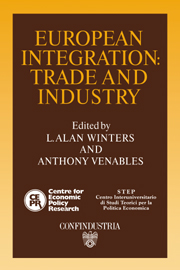Book contents
- Frontmatter
- Contents
- List of figures
- List of tables
- Preface
- Acknowledgements
- List of conference participants
- 1 European integration: trade and industry
- 2 Completing the internal market in the EC: factor demands and comparative advantage
- Discussion
- 3 External effects and Europe's integration
- Discussion
- 4 The quality and production of textiles and clothing and the completion of the internal market
- Discussion
- 5 Competition and imports in the European market
- Discussion
- 6 The structure and determinants of East–West trade: a preliminary analysis of the manufacturing sector
- Discussion
- 7 1992 and EFTA
- Discussion
- 8 Technology policy in the completed European market
- Discussion
- 9 Corporation tax, foreign direct investment and the single market
- Discussion
- 10 Japanese direct manufacturing investment in Europe
- Discussion
- Index
2 - Completing the internal market in the EC: factor demands and comparative advantage
Published online by Cambridge University Press: 07 September 2010
- Frontmatter
- Contents
- List of figures
- List of tables
- Preface
- Acknowledgements
- List of conference participants
- 1 European integration: trade and industry
- 2 Completing the internal market in the EC: factor demands and comparative advantage
- Discussion
- 3 External effects and Europe's integration
- Discussion
- 4 The quality and production of textiles and clothing and the completion of the internal market
- Discussion
- 5 Competition and imports in the European market
- Discussion
- 6 The structure and determinants of East–West trade: a preliminary analysis of the manufacturing sector
- Discussion
- 7 1992 and EFTA
- Discussion
- 8 Technology policy in the completed European market
- Discussion
- 9 Corporation tax, foreign direct investment and the single market
- Discussion
- 10 Japanese direct manufacturing investment in Europe
- Discussion
- Index
Summary
Introduction
The aim of this study is to set partial equilibrium models of the effects of completion of the internal market on particular industries into a wider general equilibrium framework. The contribution of industry-level partial equilibrium models is to capture the effects of 1992 on intra-industry trade, on competition, and hence on prices, output and welfare. As was demonstrated in Smith and Venables (1988), a pro-competitive policy change, such as completion of the internal market, can lead to substantial increases in firm scale, bringing welfare gains from lower prices and, with increasing returns to scale, lower average costs.
Partial equilibrium studies alone can for two reasons provide an incomplete, and possibly misleading, picture of the effects of completion of the internal market. First, it is assumed that resources drawn into the industry under study are available at a price equal to their marginal social opportunity cost. If one imperfectly competitive industry's expansion is – because of overall resource constraints – another's contraction, then this assumption is invalid. Employing this assumption may cause us to misestimate the welfare change associated with a policy. Second, the partial equilibrium studies assume that resources are available to the industry at a constant price, so input supply curves are horizontal. If input supply curves to each industry are in fact upward sloping, partial equilibrium studies will overestimate the quantity effects of the policy. Input supply considerations affect not only inputs of primary factors, but also inputs of intermediates, which may themselves be produced by imperfectly competitive industries, so generating ‘linkages’ between industries.
- Type
- Chapter
- Information
- European IntegrationTrade and Industry, pp. 9 - 30Publisher: Cambridge University PressPrint publication year: 1991
- 6
- Cited by



